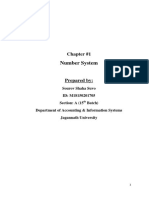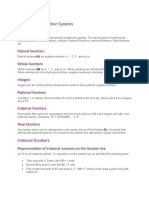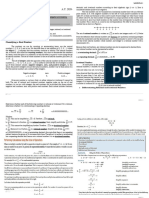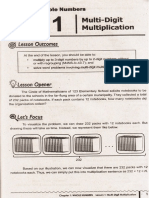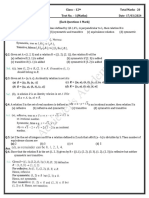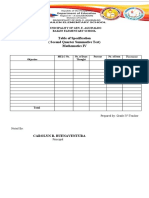Introduction to number system class 9
The collection of numbers is called the number system. These numbers are of different types such as
natural numbers, whole numbers, integers, rational numbers and irrational numbers. Let us see the
table below to understand with the examples.
Natural Numbers N 1, 2, 3, 4, 5, …
Whole Numbers W 0,1, 2, 3, 4, 5…
Integers Z …., -3, -2, -1, 0, 1, 2, 3, …
Rational Numbers Q p/q form, where p and q are integers and q is not zero.
Irrational Numbers Which can’t be represented as rational numbers
Natural Numbers
All the numbers starting from 1 till infinity are natural numbers, such as 1,2,3,4,5,6,7,8,…….infinity.
These numbers lie on the right side of the number line and are positive.
Whole Numbers
All the numbers starting from 0 till infinity are whole numbers such as 0,1,2,3,4,5,6,7,8,9,…..infinity.
These numbers lie on the right side of the number line from 0 and are positive.
Integers
Integers are the whole numbers which can be positive, negative or zero.
Example: 2, 33, 0, -67 are integers.
Rational Numbers
A number which can be represented in the form of p/q is called a rational number. For example, 1/2,
4/5, 26/8, etc.
Irrational Numbers
A number is called an irrational number if it can’t be represented in the form of ratio.
Example: √3, √5, √11, etc.
Real Numbers
�The collection of all rational and irrational numbers is called real numbers. Real numbers are denoted
by R.
Every real number is a unique point on the number line and also every point on the number line
represents a unique real number.
Difference between Terminating and Recurring Decimals
Terminating Decimals Repeating Decimals
If the decimal expression of a/b terminates. i.e. comes to A decimal in which a digit or a set of digits
an end, then the decimal so obtained is called Terminating repeats repeatedly periodically is called a
decimals. repeating decimal.
Example: ¼ =0.25 Example: ⅔ = 0.666…
Some Special Characteristics of Rational Numbers
Every Rational number is expressible either as a terminating decimal or as a repeating decimal.
Every terminating decimal is a rational number.
Every repeating decimal is a rational number.
Irrational Numbers
The non-terminating, non-repeating decimals are irrational numbers.
Example: 0.0100100001001…
Similarly, if m is a positive number which is not a perfect square, then √m is irrational.
Example: √3
If m is a positive integer which is not a perfect cube, then 3√m is irrational.
Example: 3√2
Properties of Irrational Numbers
These satisfy the commutative, associative and distributive laws for addition and multiplication.
Sum of two irrationals need not be irrational.
Example: (2 + √3) + (4 – √3) = 6
Difference of two irrationals need not be irrational.
Example: (5 + √2) – (3 + √2) = 2
Product of two irrationals need not be irrational.
Example: √3 x √3 = 3
� The quotient of two irrationals need not be irrational.
2√3/√3 = 2
Sum of rational and irrational is irrational.
The difference of rational and irrational number is irrational.
Product of rational and irrational is irrational.
Quotient of rational and irrational is irrational.
Real Numbers
A number whose square is non-negative is called a real number.
Real numbers follow Closure property, associative law, commutative law, the existence of an additive
identity, existence of additive inverse for Addition.
Real numbers follow Closure property, associative law, commutative law, the existence of a multiplicative
identity, existence of multiplicative inverse, Distributive laws of multiplication over Addition for Multiplication.
Rationalisation
If we have an irrational number, then the process of converting the denominator to a rational number
by multiplying the numerator and denominator by a suitable number is called rationalisation.
Example:
3/√2 = (3/ √2) x (√2/√2) = 3 √2/2
Laws of Radicals
Let a>0 be a real number, and let p and q be rational numbers, then we have:
i) (ap).aq = a(p+q)
ii) (ap)q = apq
iii)ap/aq = a(p-q)
iv) ap x bp = (ab)p
Example: Simplify (36)½
Solution: (62)½ = 6(2 x ½) = 61 = 6





















